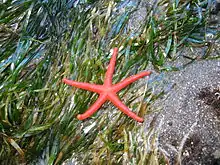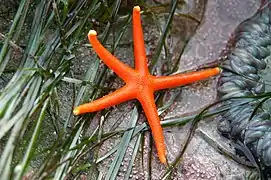Henricia leviuscula
Henricia leviuscula, commonly called the Pacific blood star, is a species of sea star found along the Pacific coast of North America.
| Henricia leviuscula | |
|---|---|
 | |
| Scientific classification | |
| Domain: | Eukaryota |
| Kingdom: | Animalia |
| Phylum: | Echinodermata |
| Class: | Asteroidea |
| Order: | Spinulosida |
| Family: | Echinasteridae |
| Genus: | Henricia |
| Species: | H. leviuscula |
| Binomial name | |
| Henricia leviuscula (Stimpson), 1857 | |
Description
They can usually be identified by their bright orange-red color, but there can also be many variations from tan to almost purple. The disk can be a mottled gray color. There can also be a saddle-like marking of lilac blotches between the rays, but the rays are not mottled.[1] They commonly have 5 rays (occasionally 4–6). The rays are smooth and appear smooth due to the lack of pedicellariae and spines. The species is relatively small; the diameter is usually over 8 cm and rarely gets larger than 12 cm.[2] As with all seastars the blood star has a madreporite which can be seen in the image below.

Reproduction and life history
Sexes are dioecious and females are not known to brood young.[3] This statement is in conflict with other sources that state that smaller females brood their young and larger females discharge eggs directly in the water and do not brood them.[4] This is one reason that is leading biologists to believe this is a species complex.[5] Embryonic stages do not adhere to one another but float freely. Post-hatching larvae are ciliated and swim. Spawned eggs have been measured at 1342 μm diameter.[6]
Behavior
In a study comparing seastar righting behavior the Henricia leviuscula twisted arms 1 and 3 toward each other, used arms 4 and 5 to support itself on the bottom of the tank, and moved arm 2 up so it was in a sitting-like position, and began to flip itself over. Overall, it had an average righting time of 15.22 minutes.[7]
Distribution
Its range is from Alaska to Baja California.[8]
Habitat
Its habitat is the intertidal zone under rocks and protected places from the low-tide line to about 400 m deep.[9] They often have a commensal scaleworm, Arctonoe vittata.[10]
Associations
There may be hybrids and possible distinct species that key to Henricia leviuscula.[11] Subspecies are Henricia leviuscula annectens and Henricia leviuscula levivuscula.[12]
Trophic strategy
They mainly feed on sponges and small bacteria.[13] The sea star moves these tiny particles, which are captured in mucus and swept to the mouth by ciliated tracts. It may also feed by applying the stomach to the surfaces of sponges and bryozoa.[14]
Conservation status
Not listed. Predators are humans and birds.

Related names
- Chaetaster californicus Grube, 1856 synonym
- Cribrella laeviuscula Sladen, 1889 synonym
- Cribrella laeviuscula Whiteaves, 1878 synonym
- Henricia attenuata H.L. Clark, 1901 synonym
- Henricia inequalis Verrill, 1914 synonym
- Henricia lunula Verrill, 1914 synonym
- Henricia spatulifera Verrill, 1909 synonym
- Linckia leviuscula Stimpson, 1857 synonym [15]
Common names
Pacific blood star, Blood star, Blood star fish.[16]
Notes
- Kozloff, E. N. (1996). Marine Invertebrates of the Pacific Northwest. Seattle: University of Washington Press.
- Kozloff, E. N. (1993). Seashore Life of the Northern Pacific Coast. Seattle: University of Washington Press.
- Kozloff, E. N. (1996). Marine Invertebrates of the Pacific Northwest. Seattle: University of Washington Press.
- Meinkoth, N. A. (1981). National Audubon Society Field Guide to North America Seashore Creatures. New York: Chanticleer Press, Inc.
- Cowles, D. (2005). Henricia leviuscula. Retrieved May 8, 2010, from Key to Invertebrates Found At or Near Rosario Beach: http://www.google.com/imgres?imgurl=http://www.wallawalla.edu/academics/departments/biology/rosario/inverts/Echinodermata/Class%2520Asteroidea/Henricia_leviuscula4sDLC2005.jpg&imgrefurl=http://www.wallawalla.edu/academics/departments/biology/rosario/inver
- Douglas J. Eernise, M. F. (2010). Henricia pumila sp. nov.: A brooding seastar (Asteroidea) from the coastal. Retrieved May 11, 2010, from http://www.mapress.com/zootaxa/2010/f/zt02329p036.pdf
- Sarah Pearson, S. P. (2008, July 11). Righting Behavior of Sea Stars. Retrieved May 2010, 8, from https://scholarsbank.uoregon.edu/xmlui/bitstream/handle/1794/7841/Pearson-Pedemonte.pdf?sequence=1
- Meinkoth, N. A. (1981). National Audubon Society Field Guide to North America Seashore Creatures. New York: Chanticleer Press, Inc.
- Meinkoth, N. A. (1981). National Audubon Society Field Guide to North America Seashore Creatures. New York: Chanticleer Press, Inc.
- Arctonoe vittata Archived 2012-07-30 at the Wayback Machine
- Kozloff, E. N. (1996). Marine Invertebrates of the Pacific Northwest. Seattle : University of Washington Press.
- Catalogue of Life. (2008). Retrieved May 8, 2010, from Species 2000: http://www.catalogueoflife.org/annual-checklist/2008/browse_taxa.php?selected_taxon=991569
- Meinkoth, N. A. (1981). National Audubon Society Field Guide to North America Seashore Creatures. New York: Chanticleer Press, Inc.
- Lester B. Pearson College. (2001, December 1). Henricia leviuscula. Retrieved May 8, 2010, from Racerocks.com: http://www.racerocks.com/racerock/eco/taxalab/taniam.htm
- Henricia leviuscula (Stimpson, 1857). (2010, May 07). Retrieved May 07, 2010, from Encyclopedia of Life: http://www.eol.org/pages/598509
- Henricia leviuscula (Stimpson, 1857). (2010, May 07). Retrieved May 07, 2010, from Encyclopedia of Life: http://www.eol.org/pages/598509
References
- Lester B. Pearson College. (2001, December 1). Henricia leviuscula. Retrieved May 8, 2010, from Racerocks.com: http://www.racerocks.com/racerock/eco/taxalab/taniam.htm
- Catalogue of Life. (2008). Retrieved May 8, 2010, from Species 2000: http://www.catalogueoflife.org/annual-checklist/2008/browse_taxa.php?selected_taxon=991569
- Cowles, D. (2005). Henricia leviuscula. Retrieved May 8, 2010, from Key to Invertebrates Found At or Near Rosario Beach: http://www.google.com/imgres?
- Douglas J. Eernise, M. F. (2010). Henricia pumila sp. nov.: A brooding seastar (Asteroidea) from the coastal. Retrieved May 11, 2010, from http://www.mapress.com/zootaxa/2010/f/zt02329p036.pdf
- imgurl=http://www.wallawalla.edu/academics/departments/biology/rosario/inverts/Echinodermata/Class%2520Asteroidea/Henricia_leviuscula4sDLC2005.jpg&imgrefurl=http://www.wallawalla.edu/academics/departments/biology/rosario/inver%5B%5D
- Henricia leviuscula (Stimpson, 1857). (2010, May 7). Retrieved May 7, 2010, from Encyclopedia of Life: http://www.eol.org/pages/598509
- Kozloff, E. N. (1996). Marine Invertebrates of the Pacific Northwest. Seattle : University of Washington Press.
- Kozloff, E. N. (1993). Seashore Life of the Northern Pacific Coast. Seattle: University of Washington Press.
- Meinkoth, N. A. (1981). National Audubon Society Field Guide to North America Seashore Creatures. New York: Chanticleer Press, Inc.
- Sarah Pearson, S. P. (2008, July 11). Righting Behavior of Sea Stars. Retrieved May 2010, 8, from https://scholarsbank.uoregon.edu/xmlui/bitstream/handle/1794/7841/Pearson-Pedemonte.pdf?sequence=1
External links
- https://web.archive.org/web/20100722122347/http://seanet.stanford.edu/RockyShore/Echinodermata/index.html#Henricia
- http://enature.com/fieldguides/detail.asp?allSpecies=y&searchText=henricia%20leviuscula&curGroupID=8&lgfromWhere=&curPageNum=1
- https://web.archive.org/web/20100602122044/http://www.wallawalla.edu/academics/departments/biology/rosario/inverts/Echinodermata/Class%20Asteroidea/Henricia_leviuscula.html
- https://web.archive.org/web/20110725043229/http://bayscience.org/Animals/H/Henricia_leviuscula/
- Photos of Henricia leviuscula on Sealife Collection